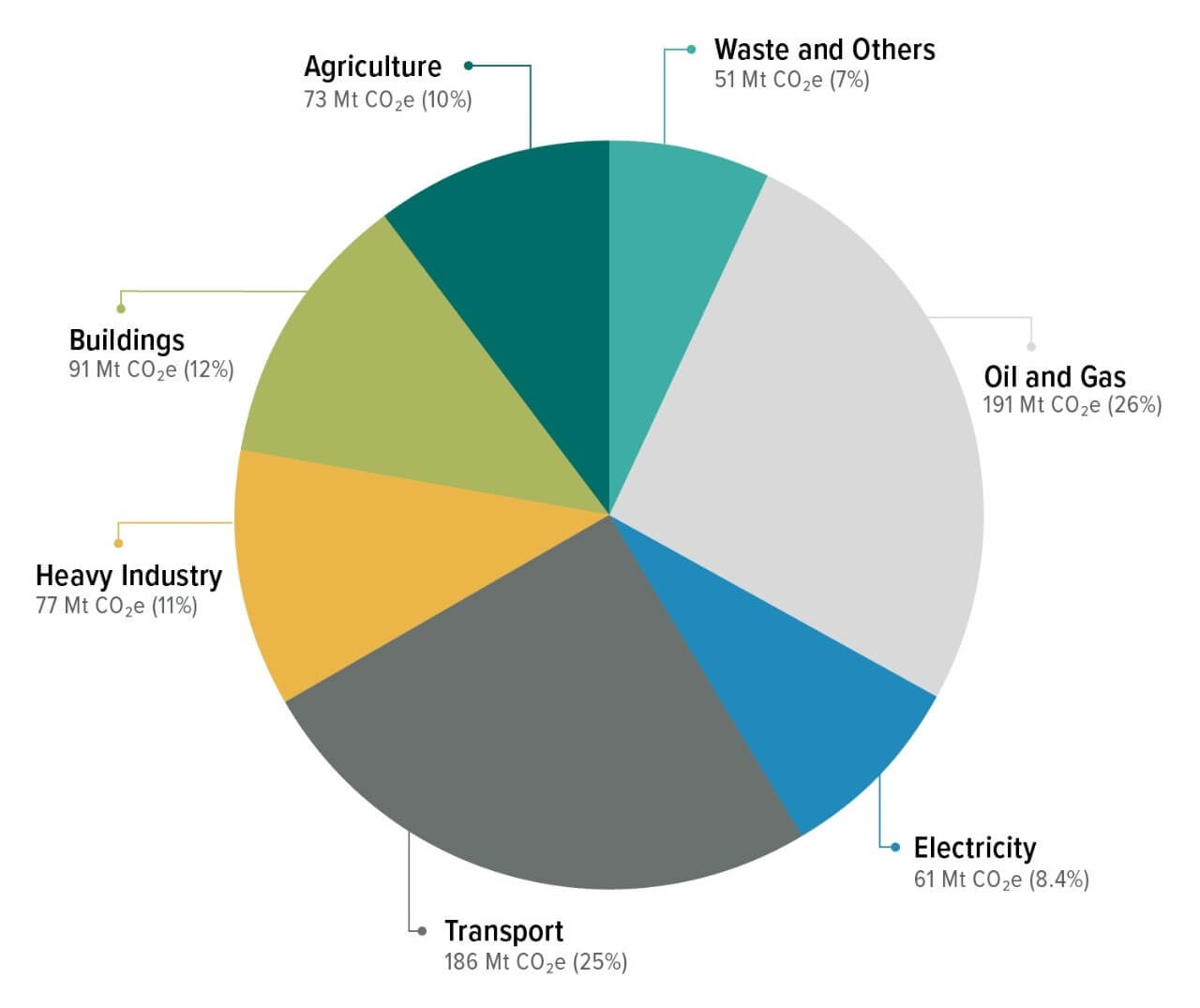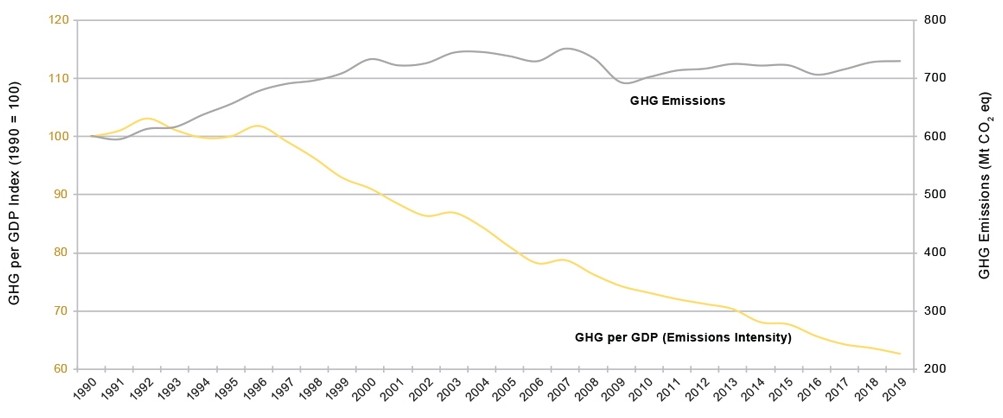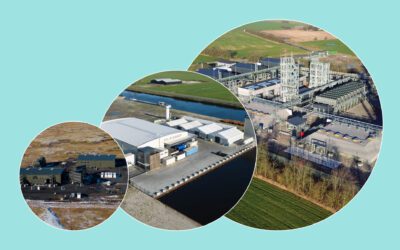By leveraging its strengths, Canada can proceed boldly in leading global progress on scaling up carbon removal. Here’s what that could look like.
The last 18 months have seen a flurry of activity in the carbon dioxide removal (CDR) space. Much of this recent progress – including the improvements to CDR tax incentives in the Inflation Reduction Act – have been concentrated in the US. This has caused some concern in Canada that their policies are falling behind, and policymakers are looking to “close the policy gap” on CDR and carbon management incentives to catch up to their neighbors to the south.
Over the last few months, I have spoken to numerous Canadian entrepreneurs and experts exploring Canada’s potential as a leader in the nascent CDR industry. I believe that Canada can do far more than “close the gap.” It can capitalize on its unique collection of strengths to become a global CDR leader. Canada’s strengths can be leveraged by policymakers, investors, and entrepreneurs to make the country a true CDR leader. It has a thriving climate start-up ecosystem, supportive R&D programs, deep technical capabilities, existing infrastructure, and vast natural endowments. These foundational strengths can enable Canada to have a catalytic impact in three main areas: advancing emerging CDR methods, shaping the global market for high-quality CDR2, and establishing best practices for efficient and equitable deployment of CDR.
Why do we need Canada’s leadership now? Well, the journey ahead is a long one. The UN’s Intergovernmental Panel on Climate Change says we need to remove billions of tons of CO2 every year by mid-century to meet our climate goals, but to date, only around 600,000 tons have been delivered. Many barriers still need to be overcome to scale up CDR, including:
- Limited research, development, and deployment (RD&D) support for emerging CDR methods and enhancements to the measurement, reporting, and verification (MRV) technologies needed to make them viable
- Scarce large-scale, long-term revenue predictability to create a mature, attractive market for CDR developers need to improve their technologies
- A lack of standards and industry experience to efficiently and equitably deploy CDR solutions at scale
To date, Canada’s strengths have been vastly underutilized in efforts to address these and other barriers. With the CDR industry still in its infancy, the opportunity for Canada to carve out a global leadership role is ripe and the long-term payoff for the climate could be substantial.
My aim with this post is to describe the strengths that could position Canada as a global CDR leader, highlight potential leadership ideas for Canada to explore, and suggest a way forward for defining a vision and strategy. The ideas I posit here are simply ideas meant to spark discussion and debate. Ultimately, defining Canada’s future in CDR must be inclusive, informed by Canada’s unique context, and representative of diverse perspectives. With COP27 underway, however, it is worth emphasizing how much the world could benefit from the strengths that Canada brings to bear to advance this critical climate solution.
The Canadian landscape

Edmonton, Alberta, the city is hours away from some of the largest oil fields in North America
With 38 million people, Canada is roughly the population of California. It has the world’s second largest land mass and the world’s longest coastline. Its GDP clocks in at almost US$2 trillion, making it the 9th largest economy in the world, with real estate, manufacturing, and extractive industries like oil and gas and mining rounding out the three largest industries. In fact, Canada is one of the world’s largest oil producers.
Canada is warming at twice the global average rate, with its northern territories warming three times faster than the global average. Canada’s greenhouse gas emissions (GHGs) were about 730 million tonnes per year in 2019 (9th highest globally) and its Nationally Determined Contribution (NDC) under the Paris Agreement is to reduce its emissions by 40-45% below 2005 levels by 2030. Reaching these targets will be a tall order given that Canada’s emissions have remained mostly flat since 2005 and policies enacted to date have yet to translate into significant emissions reductions. While overall emissions intensity is decreasing, emissions from Canada’s oil and gas and transport sectors have grown since 2005. Emissions from heavy industry and agriculture make up over 20% of Canada’s emissions, and have seen modest decreases. Meanwhile, Canada’s electricity grid is 82% emissions-free, which the government claims is on track to be 90% emissions-free by 2035.

Breakdown of Canada’s GHG Emissions by Economic Sector Source: Canada Emissions Reduction Plan 2030
The Canadian Net-Zero Emissions Accountability Act legislates Canada’s commitment to achieve net-zero GHG emissions by 2050 and requires the government to set five-year emissions reduction targets and develop science-based plans to achieve them. Earlier this year, the Canadian government published its 2030 Emissions Reduction Plan, laying out next steps in reaching Canada’s 2030 emissions targets (a 40% reduction from 2005 levels). Notably, Canada has a national price on carbon, which has risen to $50/tonne in 2022 (up from $20/tonne when enacted in 2019), and is designed to rise $15/tonne every year until it reaches $170/tonne by 2030.

Canadian GHG emissions and indexed trend emission intensity (excluding Land-Use Change and Forestry) Source: Canada Emissions Reduction Plan 2030
Specific mention of CDR in Canada’s Emissions Reduction Plan is limited, except for brief references to it within the context of traditional carbon capture, utilization, and storage (CCUS) or carbon capture and storage (CCS). This occurrence is common in much of my research, where references to CDR are intertwined with CCS/CCUS – technologies that typically reduce emissions from a point source (for example, an activity that involves burning fossil fuels). But CDR and CCS are not the same thing. I will expand later on why not clearly distinguishing CDR from CCS/CCUS could hold back Canada’s progress. In summary, the Canadian landscape boasts a supportive policy environment for climate action, making it well-positioned to lead in CDR.
Canada’s four key strengths
Canada benefits from a powerful combination of capabilities that policymakers can build on as a foundation for creating a dynamic industry that can help accelerate global progress on CDR. While these strengths are certainly not exclusive to Canada on an individual basis, considering these strengths in unison and pairing them with a policy environment supportive of climate action makes Canada uniquely positioned to lead in this space.
1. Thriving start-up ecosystem
Canada has the early makings of a thriving CDR start-up ecosystem. Many companies have found Canada to be an attractive destination to start or grow a CDR or carbontech5 company today. Some household names as well as recent entrants include:
- Carbon Engineering, direct air capture;
- CarbonCure, CarbiCrete, and Carbon Upcycling Technologies, carbon mineralization into building materials;
- CERT Systems, converting CO2 to chemical feedstocks;
- Carbin Minerals, direct air carbon mineralization;
- Planetary, ocean-based CDR;
- Mangrove, CDR credit inventory management; and
- Shopify, a leading buyer and market-shaper in the CDR field.
Thanks to the early successes of these companies, Canadian investors have some familiarity with CDR and carbontech, making it easier for credible new entrants to attract capital. A dynamic community of CDR companies can, over time, create support structures and talent clusters necessary for industry growth. Leading accelerators like Foresight/carbonNEXT and MaRS Discovery District have well established climate tech programs with experience supporting hundreds of climate start-ups and are deepening their work in carbon management to speed up commercialization in this field. This climate business ecosystem creates a strong enabling environment in which CDR startups can thrive.
2. Research and development programs
Canada’s RD&D ecosystem is highly supportive of early stage experimental development, applied research, and basic research. The Canadian government offers generous tax credits for companies engaged in research and experimentation through its Scientific Research & Experimental Development (SR&ED) tax incentives. Salaries, materials used in research, and even some overhead costs can be claimed as part of the SR&ED tax credit – ideal for experimental CDR technologies that may have long commercialization lead times. Climate specific funding is also available through relatively nimble and generously funded cleantech R&D programs. Sustainable Development Technologies Canada has over $750M over 5 years for start-ups to scale new clean technologies. Natural Resources Canada’s Energy Innovation Program funds RD&D needed to transition Canada to a low carbon economy – including calls for proposals that are soon to be open for carbon storage and utilization projects.
These RD&D programs may not be CDR-specific, but they are applicable to CDR projects to help reduce the cost and lower the risks of experimenting with novel CDR approaches. These benefits are absolutely critical, as new CDR methods could potentially be more affordable, scalable, or effective than incumbent approaches.
3. Infrastructure and technical expertise
Canada has favourable geologic formations for CO2 storage, comprehensive and effective regulatory regimes for siting, permitting, and operating CO2 capture and storage, and the technical expertise and track record to bring CO2 infrastructure online. In fact, Shell’s Quest CCS facility near Edmonton has stored over 6 million tonnes of CO2 underground since 2015. The province of Alberta recently launched a carbon storage hub to enable more companies to take advantage of Alberta’s infrastructure and expertise in geologic storage. In British Columbia, scientists with the Solid Carbon project are exploring the potential to permanently store CO2 in the subseafloor of the Cascadia Basin.
Applied research organizations are plentiful and have deep expertise in areas that are highly relevant to CDR start-ups. For example, Carbon Management Canada operates a facility that enables innovators to test the accuracy and cost-effectiveness of technologies for measuring and verifying CO2 injected underground. Ocean Networks Canada plans to use its extensive network of subsea data collecting instruments and ocean sensing systems to support ocean-based CDR solutions. In Atlantic Canada, the Ocean Frontiers Institute is quickly becoming a research and innovation hub for ocean-based CDR start-ups.
Additionally, the expertise of Canada’s workforce stemming from its well established oil and gas, forestry, mining, and ocean sciences industries will be essential to building a talented workforce needed for a thriving CDR industry. And where skills gaps exist, Canada’s forward-looking immigration system is a huge asset for attracting global talent. Few other countries have this potent combination of existing infrastructure, technical expertise, and a skilled workforce necessary to rapidly deploy cutting-edge CDR technologies.
4. Natural endowment
The scalability of CDR methods often depend on the availability and limits of natural resources. Canada’s vast biomass resources, large land areas, diverse topography, and massive coastline means that just about any CDR method can find a home in Canada. For example, the country’s massive forested area offers vast forest residues that can be used as inputs for biomass-based companies. The world’s longest coastline creates many opportunities for ocean CDR start-ups, and significant mineral deposits in Canada yield ample inputs for enhanced rock weathering. To be clear, utilizing these natural resources absolutely requires clear boundaries and responsible stewardship. Equitable partnerships with Indigenous communities and other relevant stakeholders are central to determining the placement, footprint, and distribution of benefits from any CDR project.

Natural resources used in service of CDR must be utilized responsibly and in consultation with relevant stakeholders
Three ideas for how Canada can lead in CDR
Cultivating Canada’s strengths and developing new capabilities will be critical for Canada to actually take a leadership role in the global CDR industry. Canada is well positioned to tackle three main barriers currently facing the global CDR landscape:
- A lack of RD&D support for emerging CDR methods and MRV technologies;
- Scarce long-term, large-scale demand for CDR; and
- Limited experience in efficiently and responsibly deploying CDR solutions.
The following ideas can be potential areas of leadership and investment for Canada to leverage its existing strengths, build new capabilities, and become a global driver in accelerating CDR.
Canada can create an ambitious RD&D agenda that
leads the world in incubating emerging CDR methods
There is a critical need to finance and support RD&D programs that advance research in emerging CDR methods such as enhanced weathering and ocean-based CDR. Significant innovation is still needed to responsibly and affordably deploy these new methods while developing effective, scalable MRV technologies that can improve their viability. Offering new RD&D opportunities will draw on Canada’s existing technical capabilities for research in these areas and crowd-in expertise from Canada’s universities and research institutions.
The challenge will be to ensure RD&D support applies to as many emerging CDR methods as possible in early years, but responsive enough to double-down on promising advancements as they develop over time. As promising CDR approaches come into focus, industry and government can establish innovation hubs to streamline permitting, accelerate pilot projects, and help entrepreneurs access funding, partnerships, and technical expertise to reduce the time from lab to market.
Carving out a role as a leading incubator for emerging CDR approaches can attract the next wave of CDR entrepreneurs to launch their start-up journey in Canada. Innovators can develop solutions that are piloted, commercialized, and deployed in Canada first, and eventually exported around the world.
Canada can be a leader in public procurement
to shape the market for high-quality CDR
Canada can pilot the use of global market shaping or financing tools like advance market commitments (AMCs)8 and contracts for difference to create a predictable, more mature market for high-quality CDR solutions9. These tools can attract private investment and/or offer suppliers the guarantees they need to invest in reducing the technical, pricing, and logistical hurdles to scaling up their solutions.
Government procurement can be a powerful lever for setting a high standard for CDR deployment. According to Carbon180, direct government procurement of CDR has a number of benefits:
- it can be technology neutral by focusing on quality metrics over specific technologies;
- it can establish strong MRV standards;
- it can require meaningful community engagement, co-benefits, and labor practices to ensure just and equitable deployment; and
- it can support new CDR innovations while driving down cost.
While many countries can in theory conduct CDR public procurement, the Canadian government is building expertise in evaluating climate-beneficial projects through its GHG Offset Credit System and the province of Alberta has a promising track record in renewable energy procurement that if expounded upon, can serve as a blueprint for Canadian leadership. Public procurement of CDR is not without its risks, but odds of success can be improved by starting small, using partnerships to crowd in private capital, setting high procurement standards, and leveraging Canada’s vast climate expertise from industry and academia in procurement decisions. Early thinking on this appears to be under way, as the Canada Growth Fund (recently launched by the Canadian government) references contracts for difference and offtake contracts as potential financial instruments that could be used to support promising climate technologies.
As an early mover in public procurement, the Canadian government can benefit from innovative, responsibly deployed, high-quality CDR projects within its borders while helping shape the market for these types of CDR projects globally. Ultimately, the government and its partners can work with other countries to establish similar systems, and eventually play a leading role in creating global funding mechanisms (think Gavi’s role in vaccines) with significant buying power and high-quality standards that CDR suppliers around the world will aspire to meet.
Canada can set a global standard for
efficient and equitable CDR deployment
Because Canada already has favourable geologic formations for CO2 storage, technical expertise to develop and maintain CO2 storage infrastructure, and clear siting and permitting regulations in place to operate these sites, it is well positioned to efficiently and equitably scale up CDR projects. Where gaps exist, federal and provincial regulations and implementation guidelines can be adapted or developed to ensure that project developers engage in robust community engagement, employ high labour standards, utilize effective MRV systems, and abide by stringent ecological requirements. Canada’s well-trained regulators can be equipped to ensure these requirements are met while streamlining projects that meet high standards. Community leaders can be empowered to ensure that Indigenous communities, coastal communities, labour groups, and other relevant stakeholders are equitably and inclusively involved in the design and deployment of CDR projects.
Implementing CDR in a responsible manner while balancing the need to deploy these technologies quickly will be extremely difficult, but is absolutely critical to global success. Best practices employed at the federal and provincial level — while not perfectly adaptable to other contexts – can be a foundation for how other countries can quickly, safely, and inclusively scale this critical climate solution.
What is holding back progress?
Canada’s potential as a CDR leader may be hampered by a lack of policy clarity and coherence that distinguishes CDR from traditional CCUS. While some CDR technologies may leverage CCUS infrastructure, climate experts have articulated roles specific to CDR:
- fully neutralizing remaining emissions from sectors without affordable and scalable emissions reduction alternatives;
- removing historical carbon dioxide emissions;
- addressing potential climate overshoot and non-carbon dioxide GHG emissions; and
- tackling a broader climate justice agenda.
Aside from a proposed investment tax credit that covers capital costs for direct air capture projects, CDR-specific policies or even definitions are few and far between in Canada, leaving the country less equipped to harness the full potential and evaluate possible risks associated with the diverse suite of CDR technologies.

The difference between carbon removal (CDR) and carbon capture and storage (CCS) Source: Nicole Kelner by way of Carbon180
A recent article in the Alberta Law Review argues that Canada’s lack of a policy strategy relating to CDR limits the government’s ability to manage the risks associated with scaling up CDR and makes potential stakeholders less inclined to invest in and implement CDR within Canada’s legal framework. I would agree. The lack of a comprehensive, CDR-specific vision and strategy leaves a number of unanswered questions, including:
- What needs to be done to gain public acceptance to deploy different types of CDR technologies?
- What are the implications of scaling up energy-intensive CDR methods on Canada’s clean energy goals?
- What CDR-specific regulatory bottlenecks exist and how can governments at all levels work together to address them?
- To what degree can CDR projects benefit from Canada’s carbon pricing system?
Encouragingly, there has been some early progress made to define a vision and path for CDR in Canada. The Canadian government recently embarked on developing a national CCUS strategy (of which CDR will be one component) and announced the Canada Growth Fund which could potentially benefit CDR projects. At the provincial level, British Columbia is planning to develop a blueprint for scaling carbon management practices and the Pacific Institute for Climate Solutions has urged the province to develop a comprehensive CDR strategy. This progress can be embraced to build further momentum around CDR in Canada.
Defining a vision and strategy
I believe any future Canadian CDR vision or strategy should aim to carve out a global leadership role for the country. Given Canada’s strengths, the broad imperative for CDR scale-up, and the clear opportunities to have a catalytic impact in the space, Canadian policymakers and their partners should seek to strategically address critical global needs to scaling up CDR. Of course, any strategy would need to be considered as part of a broader policy response to recent U.S. climate policies such as the Inflation Reduction Act. Fortunately, promising policy efforts and new initiatives are underway to establish CDR strategies in Canada. Going forward, defining a vision and strategy for Canada’s global leadership in CDR will require three things:
- First, creating political durability for CDR by generating buy-in among a diverse set of stakeholders at local, provincial, and federal levels. For example, a vision for scaling up CDR must include the perspectives of Indigenous and coastal communities who have important insights on how land and water resources should be used and protected, as well as workers in extractive industries who could benefit from transitioning their skills to a new sector. It is worth taking the time to engage as many stakeholders as possible and incorporate their perspectives, which will help ensure CDR remains a priority even as local, provincial, and federal governments change.
- Second, differentiating Canada’s vision and strategies for advancing CDR from advancing traditional CCUS. If CDR is viewed as a tool within Canada’s existing CCUS agenda, it could fail to capture the public’s imagination, the expansiveness of CDR’s potential, the diversity of its approaches, all while neglecting to address the complexity of the challenges associated with scaling it up.
- Finally, intentionally going above and beyond Canada’s domestic economic and climate priorities as it seeks to shape a strategy or vision. Because scaling up CDR is a global imperative and Canada has so much to offer, policymakers and their partners should engage with stakeholders around the world to identify areas where it can fundamentally benefit the CDR landscape to help achieve global climate goals. In addition to asking what CDR can do for Canada, I hope Canada can also seek to answer “What can Canada do for CDR?”
As a Canadian steeped in the CDR field, it is my hope that whatever direction Canada takes, it moves boldly forward in channelling its strengths to scale up CDR.







